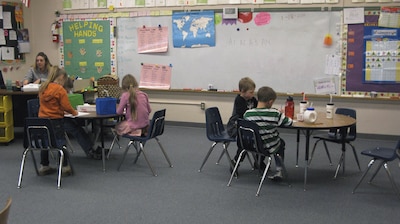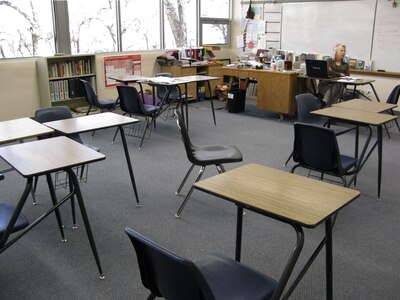
The Agate School District boasts a top-notch facility. A $1.8 million capital construction grant from the state in 2003 paid for a sparkling new cafeteria and kitchen in the district’s one school. The gym has been updated, and spacious new locker rooms were added. There’s even a new fitness room housing state-of-the-art equipment.
There’s just one thing lacking: students.
The district, which encompasses 458 square miles of rural Elbert County, enrolls only 26 students, which makes it the smallest school district in the state.
That’s down seven students from the fall, when its official student count stood at 33 – still the smallest in the state, this year or any year. That was before one family with four children had to move away. And then another. And another.
“The enrollment has ebbed and flowed over the years,” said Kendra Ewing, who serves as both superintendent of the district and principal of the school. “There are times it’s been in the 20s before, and they thought then, ‘Oh my gosh, what will we do?’ But then a new housing development brought in an influx of students.”
This time, though, she and longtime district business manager Vic Cravens agree the economy is complicating a return to higher numbers.
“We had 20 families with children attending school here in the fall,” said Cravens, also a former school board member and Agate High School Class of ’73 alum. “And six of them were unemployed. You have to have money to live here.”
A steady decline over the past 10 years
A decade ago, enrollment in Agate peaked at 132. Since then, the decline has been steady. And like many small school districts across Colorado struggling with declining enrollment, the prospects for remaining a viable independent district grow slimmer with each departing child.
Student view
“I’d say the only thing I’ve missed out on by going to a school this small is a lot of pointless drama.”
– Tyrel Sorensen, 17, one of two in Agate’s Class of 2011.To serve its 26 students – 12 in high school, five in middle school and nine in elementary school – Agate has a nearly $1.2 million budget for the 2010-11 school year. More than 70 percent of that comes from the state, which sets aside a relatively generous per-pupil allotment for rural school districts, and lets a district with declining enrollment average out its head count over four years, so a sudden drop in enrollment won’t cause quite so catastrophic a loss of revenue.
That means Agate is actually collecting state funds this year as though it were serving 51 students rather than the 37 it projected it would have, the 33 it opened the year with or the 26 it has now.
Building a budget based on 26 students gets substantially harder. Making it harder still was the unwillingness of district voters to approve a requested mill levy increase last November. The higher local taxes would have helped offset the inevitable decrease in state funding. Without it, district officials are looking for other ways to survive.
Eight teachers for 26 students
The current budget covers the cost of paying eight teachers and a classroom assistant, plus the administrative staff and the cost of maintaining and operating the building.
That seems like a lot of teachers for so few students, but Ewing insists it’s not.
“We keep paring down every year, but you have to have highly qualified teachers in every classroom,” she said. “In our elementary school, the ratio doesn’t have to be that high, but in high school, you have to offer four years of English, all the math requirements, all the science requirements. We have highly educated teachers, but typically you won’t find one person who has endorsements in math, science, English and social studies. People talk about the one-room schoolhouse, but they didn’t have the requirements then that we have today.”

A huge chunk of the budget – just over $97,000 – is set aside just for transportation. The district went to a four-day week several years ago to curb some of those costs.
Agate’s students are spread out all over the district, and while the town of Agate itself is an easy 75-minute drive east on I-70 from Denver, only two students actually live in Agate, Ewing said. Many live 25 to 30 miles away and must travel over muddy, unpaved roads to get to school.
“We spend a lot of money on vans and buses to get the kids, but that’s the only way to make it work,” said Craven. “Doing away with buses just isn’t a feasible way for us to cut costs.”
With much of the budget made up of fixed or rising costs, and state and federal mandates prohibiting the elimination of other things, those things that can be cut gradually have been.
Music was among the first to go, back in the 1980s. Art classes disappeared about 2006. The district fielded its last sports teams – in volleyball, basketball and track – during the 2008-09 school year. Now students who want to participate in sports play for nearby Deer Trail.
But now, there’s not much left to cut, and if you cut too much, the remaining students are likely to go elsewhere, Ewing says.
“We are looking at some different possibilities for next year to see what we can do to sustain the district,” she said.
Online possibility raises hackles
Among the possible scenarios: the high school could close and the older students could be sent elsewhere; the district could consolidate with another nearby district; it could close altogether and be absorbed by one or more neighboring districts; it could again seek a tax increase from local voters; or it could try to attract students online.
That’s what several rural districts have done, including the tiny Branson school district in Las Animas County. In fall 2000, the district was the state’s smallest with 42 students. Today, Branson has 470 students – 427 in an online school, 13 in an online GED prep program and 30 in the district building.
“I’m not saying we won’t consider going online,” said Ewing. “Everything is on the table now.”
But for some, offering online classes poses some ethical questions.
“In my mind, if everyone in the state started an online academy, is that really necessary?” asked Lyndon Burnett, chair of the Agate board of education and past president of the Colorado Association of School Boards.
“Would we be starting it to really serve our kids or just to bring money into the district? If we had a legitimate reason for doing it, and if it was really helpful to kids, that would be another story,” he said. “But I don’t feel we should do it just to raise money. There are all kinds of programs out there now, and it’s just not feasible for every school district who has problems.”
Yet the other options have their own unpleasant consequences.
Consolidating with one other school district inevitably means bussing some children 30-40 miles to school, when there might be a nearer school in a different district only 10-15 miles away. Closing the school altogether will cost decent jobs in a community that already doesn’t have much in the way of non-agricultural employment.
But does keeping the school open at all costs serve the children who continue to attend?
“You can get down to the point where you’re no longer offering a quality education,” Burnett acknowledged. “We don’t have music and we don’t have sports. Our kids test well, but are we doing them a disservice by trying to keep the school open?”
Then there’s the little matter of that new cafeteria and gym.
“Our school is in excellent condition,” Burnett said. “If it were falling down and getting written up by the state, with as few students as we have, keeping it open wouldn’t even be a consideration. But it’s not. It’s been all fixed up and has a lot of additions.”
Ewing knows the odds are against Agate. Yet the district has some notable strengths. It routinely has a 100 percent graduation rate. The vast majority of its students score proficient or better on state-mandated tests. And it has an outstanding Future Farmers of America program that attracts students from nearby districts.
“It was hard to get any attention … Not here.”
“I’ve gone here for 14 years,” said Tyrel Sorensen, 17, one of two members of the graduating class of ’11.
When he graduates from high school, he’ll also be awarded an associate’s degree from Fort Morgan Community College, since he’s been able to take classes for college credit thanks to the ECBOCES V-net, a distance learning system that connects 19 of the 21 schools districts on the eastern plains.
“I’d say the only thing I’ve missed out on by going to a school this small is a lot of pointless drama,” Sorensen said.
His classmate, Cody Rusher, 18, recalls with disdain what it was like to attend school at a large Adams County high school, before his family moved out to Elbert County.
“It was hard to get any attention from teachers,” he said. “It was easy to be missed. Not here.”

Sylvia Uhl teaches English to everybody in middle and high school. There are the sixth- to eighth graders; then the ninth- and 10th-graders; then the juniors and seniors.
“My biggest class is the ninth and tenth graders,” she said. “I’ve got six kids in that class, including two honors students.”
She also teaches social studies to the middle-schoolers, advises the student newspaper, just inherited oversight of the gifted-and-talented program, and is working on her ESL endorsement, so she can better serve the school’s two English language learners.
“My friends say I’m crazy,” said Uhl, now in her second year at Agate. “But once you raise the bar that high, then reach it, you get into a groove. Less work would be better, but I want my students exposed to the very best.”
Down the hall, elementary teacher Megan Donnellon has figured out how to tend to the needs of youngsters ranging in age from 5 to 10.
“It was hard to teach them all writing at the same time,” she said. “But that was in the fall. It’s better now.”
Meanwhile, Jacob Pike, the school’s only third-grader, exults in his unique status. “It’s awesome,” he said.
Weighing the value of small schools
For all the challenges ahead, Ewing believes passionately in the worth of small, rural schools. She knows what they mean to their surrounding communities. And yes, she knew what she was getting into when she accepted the superintendent’s job in Agate.
“I live in Genoa,” she said, a small town 30 minutes east of Agate. “We lost our school in ’84 when it consolidated with Hugo. I know what that’s like. My husband was a teacher in Arriba, and they lost their school to consolidation. I believe in these little school districts.”
Agate is certainly not the only small district facing difficult choices. The DeBeque school district in Mesa County – with an enrollment of 136 last fall, five times that of Agate – has seen its enrollment cut in half in the past few years, and is threatening to close its high school if voters don’t pass a tax increase this fall.
“We may be the first to do something drastic, but we won’t be the last,” warned Burnett.
“There will be more school districts that will consolidate or close down. It’s tough times. If it were just a matter of hanging on for a year or two until things got better, that would be one thing. But I don’t see any more money coming from the state for the foreseeable future. And we can’t print money in Agate. This situation doesn’t serve anybody well, but it is what it is.”
